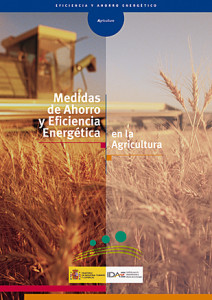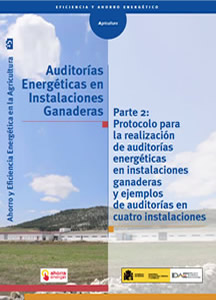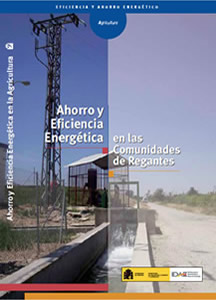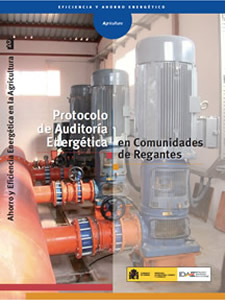Energy saving and efficiency documents - agriculture
The IDAE, with the collaboration of the Ministry of Agriculture, Food and Fisheries, is developing a series of publications on energy efficiency in the agricultural sector in order to raise awareness among industry stakeholders about the importance of energy efficiency.
This series of publications includes various technical documents that explain methods for reducing energy consumption in a range of agricultural tasks.
Brochure: Savings and Efficiency Measures in Agriculture
In the E4 preparation phase, it was decided to incorporate Agriculture as a specific sector of action, highlighting the importance that energy efficiency measures could have in the future in this strategic sector...
Energy saving and efficiency in agriculture: irrigated land
Spain is the only European country, even considering those in the Mediterranean, with a semi-arid surface covering more than two thirds of its territory, and it has the most extensive irrigated land. In addition, if you analyse rainfall or evapotranspiration, it is easy to see that our country has...
Energy Saving and Efficiency in livestock installations
The intensive livestock sectors, mainly swine and poultry, are undergoing continuous evolution. On the one hand, this is motivated by the application of new sanitary regulations and environmental protection, and on the other hand, it’s due to the restructuring of the sector to adapt to the levels of...
Livestock farms have variable energy consumptions, broadly depending on the climate where they are located and the type of farming. Taking an inventory, analysing the results and giving alternatives to a farm’s energy consumption is a task that will give economic benefit and reduce the cost of operation, increasing the competitiveness of the end product. This document provides the theoretical basis for conducting an energy audit in a livestock farm, indicating methods and calculations to be used for each of the farm’s subsystems. It also provides recommendations and techniques for optimising energy consumption.
With this protocol, each of the farm’s subsystems is analysed from the energy point of view, identifying the weak points of low energy efficiency in order to propose solutions that improve energy use. This energy audit protocol is designed to be a useful tool to assess and reduce, where appropriate, the energy consumption of livestock farms and the associated economic cost.
The decision that most determines a farm’s level of diesel consumption is the selection of the crops, and the associated type and number of agricultural operations required by each. However, once this decision is made, the selection and adaptation of the machinery..
Energy consumption in agricultural operations in Spain, published jointly with the Ministry of Agriculture, Food and Fisheries.
Energy Saving and Efficiency in Tillage Systems
In extensive agriculture, tilling the soil is the activity which consumes the greatest amount of fuel, so choosing the most appropriate tillage for each case is very important when aiming to achieve the highest energy efficiency.
Energy Savings and Efficiency in the Structure of Agricultural Exploitation
To close the trilogy on the saving of diesel in agriculture (the previous two focused on the tractor and agricultural operations) this report considers the structure and dimension of the agricultural production as a decisive factor for energy saving through efficiency in agricultural work.
Energy Saving and Efficiency in Nitrogen Fertilisation
Nitrogen Fertilisers are applied to improve agricultural productivity. But, like water and energy, they are resources which must be managed efficiently during both their production and their application. This publication presents the high energy cost of nitrogen mineral fertilisers and analyses the alternatives that make it possible to reduce their use in agricultural operations to a minimum, or use them as efficiently as possible.
Energy Saving and Efficiency in Greenhouses
An excessive consumption of energy not only negatively affects the environment, but also negatively influences the economic balance of farms and the image that the sector projects to society. The average spend on energy in greenhouses has grown in recent years, largely due to inefficient energy use. This publication identifies the energy needs of a greenhouse, then presents a series of concrete measures to improve savings and energy efficiency, as well as the possibility of using renewable energy in these agricultural systems.
This publication, as a continuation of the previous document (Energy Saving and Efficiency in Greenhouses), explores in more detail how an energy assessment is carried out in a greenhouse and develops an energy audit protocol model with an explanatory example. This energy audit protocol for greenhouses is intended to be a useful tool to assess and reduce, where appropriate, the energy consumption and economic costs of greenhouses to farming businesses.
Energy Saving and Efficiency in Irrigation Communities
This publication deals with the characteristics of irrigation communities, describing their main infrastructure and identifying the critical points of their existing energy consumption. A range of measures to improve energy efficiency and make savings in the irrigation communities are then described. Both energy and economic aspects are considered and there is a description of each of the proposed measures and how they improve energy efficiency and make financial and energy savings.
Protocol for Energy Audits in Irrigation Communities
The E4 Action Plan 2008-2012 includes measures for Irrigation Agriculture focused on the migration from sprinkler irrigation systems to drip irrigation systems and the promotion of energy improvement plans in Irrigation Communities through the Energy Audits for which IDAE has developed the audit protocol explained in this publication. With this protocol, weak points of lower efficiency in the irrigation community can be identified and energy improvement solutions proposed that will lead to a reduction in the energy and economic consumption of irrigated farms. This publication is also the report model of a computer application called “Energy Audits in Irrigation Communities”. This computer application, which works in a database environment, allows the different audits carried out by companies specialized in this field to be automated and correlated. The knowledge learned can thus be applied over time.
Energy Saving and Efficiency in Energy Crops and Agriculture
Agriculture, in addition to savings in and efficient use of diesel and the raw materials used in the production process, has another way of contributing to the policy of reducing greenhouse gas emissions: the production and sustainable use of agricultural biomass. Of course, it will be necessary to analyse the energy balance and greenhouse gas (GHG) emissions avoided in the production, storage and transport of the biomass. It will also be necessary for farmers to find sufficient economic incentive and profitability in the production of biomass for energy purposes, since otherwise it will not be possible for this sector to develop successfully. The objective of this publication is to inform farmers of the most energy efficient ways to generate and use biomass, in their dual roles of biomass producer and potential user of that biomass to cover their own energy needs.
Energy Saving and Efficiency in Conservation Agriculture
In general, current conventional agricultural techniques involve a considerable deterioration of the environment, besides constituting a model of production that could clearly be improved in terms of energy use. Conventional agriculture, by including practices such as intensive tillage, significantly increases runoff and soil erosion and the pollution of rivers by sediments, fertilisers and pesticides. The practical application of conservation agriculture is based on a drastic reduction (even elimination) of tillage. By not tilling, there is vegetation cover on the soil surface with the remains of the previous crop which, rather than negatively affecting the soil, protects it from erosion and nourishes it naturally. In addition, it encourages the presence of microorganisms and fauna which actively help the farmer to improve the yield, even if they cannot be perceived by the naked eye. Finally, another important advantage of conservation agriculture is its greater economic profitability in comparison with conventional agriculture. The tillage of soil requires high investments in the acquisition and maintenance of agricultural machinery, fuel and labour.
Energy Saving and Efficiency in conservation agriculture. Experiences in the Field
In March 2009, IDAE published “Energy Saving and Efficiency in Conservation Agriculture”. In this publication, the different techniques used in conservation agriculture in Spain were explained from an energy and agronomic point of view. The agro-environmental benefits of conservation agriculture were also described.
As a follow-up, the IDAE has published this very practical document which aims to give the reader an insight into conservation agriculture, with the opinions and results obtained by a group of 10 farmers who have been applying this technique for more than a decade with different crops and in various regions of Spain.
Energy Saving and Efficiency in Precision Agriculture
This document addresses the fundamental concepts of precision agriculture: it studies assisted guidance and automatic guidance systems for tractors, this technology is combined with direct seeding, weed destruction techniques are considered and, in general, it addresses all agricultural work where opportunities exist for energy saving and resource reductions by applying these precision agriculture techniques. Finally, we aim to give the reader a series of recommendations through a summary of the use of these techniques, and a few key rules.
Energy Saving and Efficiency in Fishing Vessels
The Spanish fishing fleet is the largest in the European Union and one of the largest in the world. The average Spanish vessel exceeds the European average in terms of power and tonnage. This deviation is due to the large size of Spanish freezer vessels. In general, the Spanish fishing sector displays an adequate energy efficiency. With a registered fleet of more than 13,000 vessels (a third of which are older than 30 years), fuel costs are an important factor to be taken into account in the profitability of a vessel’s activities. However, there is an opportunity to apply techniques capable of acting on the energy critical points of the sector whilst maintaining production, ensuring environmental sustainability and maintaining (or even increasing) the profitability of operations. This publication analyses the different parts of a fishing vessel, from the point of view of energy consumption, identifying critical points of energy consumption and giving guidelines and techniques to reduce them, both in the design and construction phase in the shipyard and during daily operation. In addition, a model protocol for energy audits in fishing vessels has been developed. This model was designed to be a tool to help companies specialized in the field to asses a vessel’s points of lower efficiency and to propose solutions for improvement, both structural and in habits of use, all aimed at reducing energy consumption.
Energy Saving and Efficiency in Fishing Vessels. Experiences and Practices
In March 2009, IDAE published “Energy Saving and Efficiency in Fishing Vessels”. This publication analysed, from the point of view of energy consumption, the different parts of a fishing vessel, focusing on the critical points of energy consumption. As an annex to this publication, a protocol model was developed to carry out energy audits in fishing vessels, a model that aims to be a tool to help companies specialized in this field to asses points of lower efficiency of the vessel, and thus be able to propose improvement solutions aimed at reducing energy consumption.
Based on this audit protocol, and funded by the 2008-2012 Action Plan, more than 200 audits have been carried out on fishing vessels and measures have been proposed for the reduction of fuel consumption in all these vessels. Some of these measures have already been carried out on fishing vessels, achieving the expected savings.
With the experience gained in the development of the energy audits and the execution of the proposed measures, as well as the analysis of other projects on energy saving in fishing vessels, this publication has been adapted and developed. This is a publication which also seeks to address and summarise all the technological and innovative developments in this sector over recent years.
















